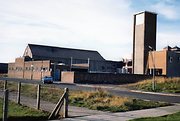 Hartlepool Sports & Leisure
Hartlepool Sports & Leisure
- Cinemas, Theatres & Dance Halls
- Musicians & Bands
- At the Seaside
- Parks & Gardens
- Caravans & Camping
- Sport
 Hartlepool Transport
Hartlepool Transport
- Airfields & Aircraft
- Railways
- Buses & Commercial Vehicles
- Cars & Motorbikes
- The Ferry
- Horse drawn vehicles
 A Potted History Of Hartlepool
A Potted History Of Hartlepool
- Unidentified images
- Sources of information
- Archaeology & Ancient History
- Local Government
- Printed Notices & Papers
- Aerial Photographs
- Events, Visitors & VIPs
 Hartlepool Trade & Industry
Hartlepool Trade & Industry
- Trade Fairs
- Local businesses
- Iron & Steel
- Shops & Shopping
- Fishing industry
- Farming & Rural Landscape
- Pubs, Clubs & Hotels
 Hartlepool Health & Education
Hartlepool Health & Education
- Schools & Colleges
- Hospitals & Workhouses
- Public Health & Utilities
- Ambulance Service
- Police Services
- Fire Services
 Hartlepool People
Hartlepool People
 Hartlepool Places
Hartlepool Places
 Hartlepool at War
Hartlepool at War
 Hartlepool Ships & Shipping
Hartlepool Ships & Shipping

Fire Stations
Details about Fire Stations
Images of Fire Stations, Fire-fighting vehicles and Fire-fighters in the Hartlepool area.
Barnard St (Clarke St now) Fire Station opened in 1890 and was replaced by the current station in Stockton St in 1959.
Location
Related items :
 Accident between a bus and fire engine
Accident between a bus and fire engine
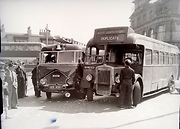 Created by NDM
Donated by Hartlepool Museum Service
Created by NDM
Donated by Hartlepool Museum ServiceDated 1955
On 30th May 1955, a fire engine which was on the way to a grass fire on the Headland, collided with a United bus at the Church Square and Stockton Street junction. The bus had come down Hart Road(now Raby Road) and was travelling to the United Bus Station. Binns store can be seen on the right behind the bus.
Another fire engine was sent to the fire and the accident took half an hour to clear, attracting a lot of onlookers at the busy juntion.
More detail » Auxiliary Fire Service
Auxiliary Fire Service
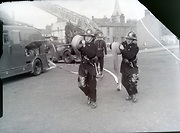 Created by NDM
Donated by Hartlepool Museum Service
Created by NDM
Donated by Hartlepool Museum ServiceTaken in the mid 1950s on waste land. Tower Street Baptist Church spire is in the background.
More detail » Barnard Street Fire Station
Barnard Street Fire Station
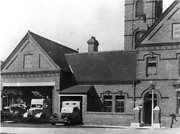 Donated by Douglas Ferriday
Donated by Douglas FerridayPart of the Hartlepool Library Services collection
Dated 1945
Barnard Street Fire Station taken in 1945. This Station was completed in 1889 at a cost of £1,225, and opened the following year. Barnard Street was renamed Clark Street following the amalgamation of Hartlepool and West Hartlepool in 1967.
HHT+N 57
More detail » Building of new Stockton Street fire station
Building of new Stockton Street fire station
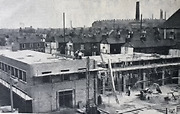 Created by NDM
Donated by Hartlepool Museum Service
Created by NDM
Donated by Hartlepool Museum ServiceDated 1958
This image was taken in August 1958 when the new fire station was taking shape . On the right of the photo the roof of the Gaumont can be seen and behind that the Durham Paper Mills tower. The angle of the photo is a bit tricky, but the houses behind the new building are St James' Place, Regent Place and Union Place .
More detail » Chief Fire Officer
Chief Fire Officer
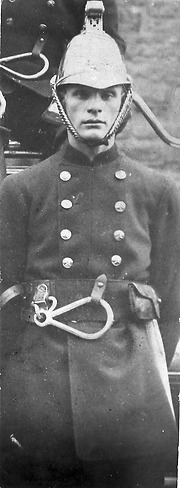 Donated by Mrs. Silvia Jolly (nee Sanderson)
Donated by Mrs. Silvia Jolly (nee Sanderson)Dated 1928
Mr Richard Hayton Sanderson, in full dress uniform as Chief Fire Officer at Richardson Westgarth, 1928.
More detail » Clarke Street
Clarke Street
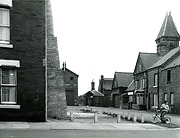 Donated by Hartlepool Library Service
Donated by Hartlepool Library ServiceClarke Street, Burbank Street junction, Hartlepool. Old Fire Station in background
More detail » Early Wartime Memories by David Willis
Early Wartime Memories by David Willis
David Willis no longer lives in the town but has kindly sent in his reminiscences of a Wartime childhood in Hartlepool.
In the late 1930s I remember the visit of the 'chocolate train', which was parked up in a dead end platform at the east end of West Hartlepool Station. The whole train was decked out in colours which from memory resembled the Cadbury colours. I made several visits as samples of various chocolates were on display and were given away to hungry kids like me. I wonder if anyone else remembers the 'chocolate train', which left many very sad small people as it finally pulled out of the station.
The other major event was the spectacular burning down of Dyke House Farm and its surrounding buildings, which I think must have been organised by the Fire Brigade, as I distinctly remember Firemen silhouetted against the flames as the fire took hold. There was also an accompanying firework display. It seemed to me that most of the town must be in attendance as we looked on from Wharton Terrace. This was prior to the house-building on the site and also that of Dyke House School, which never got beyond the foundation stage before the onset of the War, but provided a magnificent playground for children.
With regard to St Oswald Street itself, it had its own garrison of troops, stationed in a building at the Raby Road end of the street. The building was Waugh's Bakery and the soldiers were from a Scottish regiment resplendent in their kilts. Each evening a lone piper would march up and down the street. The soldiers used a large sliding door in Wharton Terrace backlane to access the building and a well-known tramp could often be seen near this door looking for scraps of food. One day the soldiers put him in a barrel of water and scrubbed him clean. Waugh's also had a cake and bread shop immediately opposite the bakery. In addition there was a further shop at the other end of the street, known as McGhees general store.
Prewar the United Bus Company had a garage on Raby Road immediately opposite St Oswald's Street which was taken over as a Fire Station for the duration, housing several large engines.
In the early years of the War, Brougham School was taken over by the army. Many of the pupils spent the next 3 or 4 years getting a part-time education in houses. For example, a group of pupils from the St Oswald Street/Chester Road area met for about three half-days a week in my parent's house (12 St Oswald's Street), next door at number 10, or at a house at the Raby Road end of Chester Road.
When Dyke House opened we resumed full time education there and I can remember growing vegetables in the quadrangles in the 'Dig for Victory' campaign. I was there for 1 or 2 years and my teacher was Miss Salt. I took the 11 plus at Dyke House before moving on to West Hartlepool Grammar School in September 1945.
Just postwar I joined the youth club run by Westbourne Church between Stranton and the Burn Valley. We had a very successful football team, playing as far afield as Darlington and Sunderland. We were known as the Guild of Youth, a future well known team member being Brian London who fought Mohammed Ali for the World Heavyweight title. I was at the Grammar School at the time, a bastion of rugby, where the Headmaster insisted on boys playing rugby in winter if they wished to play cricket in summer, which I loved. This led to all sorts of rushing journeys between morning rugby matches and afternoon soccer games, especially if these were 20 miles apart.
More detail » Fighting the fire
Fighting the fire
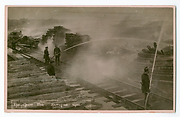 Donated by Hartlepool Museum Service
Donated by Hartlepool Museum ServiceFire Brigade personnel fight the fire.
More detail » Fire Brigade Practice
Fire Brigade Practice
 Donated by Mr. John Brooker
Donated by Mr. John BrookerCleveland Fire Brigade exercising with the Fire Boat Endeavour at the Deep Water Berth, Victoria Dock, Hartlepool.
More detail » Fire Brigade in Action
Fire Brigade in Action
 Donated by Hartlepool Museum Service
Donated by Hartlepool Museum ServiceTwo Fire Brigade Officers fighting the fire whilst workmen look on in the background.
More detail » Fire Officer Sanderson
Fire Officer Sanderson
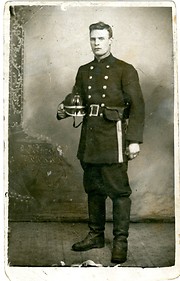 Donated by Mrs. Silvia Jolly (nee Sanderson)
Donated by Mrs. Silvia Jolly (nee Sanderson)Richard Sanderson, Chief Fire Officer at "Richies", strikes a pose in his fire service uniform.
More detail » Fire Station in Clark Street
Fire Station in Clark Street
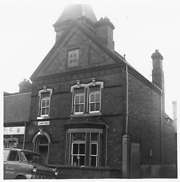 Donated by Douglas Ferriday
Donated by Douglas FerridayPart of the Hartlepool Library Service collection
Dated 1972
The Fire Station in Clark Street in 1972. This street was previously named Barnard Street. The name changed in 1967 following the amalgamation of Hartlepool and West Hartlepool.
More detail » Fire engine
Fire engine
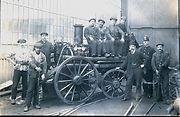 Donated by John Ludbrook
Donated by John LudbrookWorkers alongside their fire engine. Date and location unknown.
More detail » Fireman at the scene
Fireman at the scene
 Donated by Hartlepool Museum Service
Donated by Hartlepool Museum ServiceA Fireman at the scene of the fire.
More detail » Firemen date unknown
Firemen date unknown
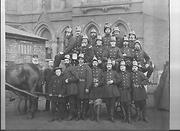 Donated by Elizabeth Forstad
Donated by Elizabeth ForstadPart of the Library Service collection
Presented to Hartlepool Library Service by Elizabeth Forstad. The helmet badges have the letters WHIC - West Hartlepool Improvement Commissioners. The photograph was taken at the rail sidings in Mainsforth Terrace, the big building in the background is the Hartlepool Exchange Building on the corner of Mainsforth Terrace/ Surtees Street.
More detail »
 Former Fire Station Clark St
Former Fire Station Clark St
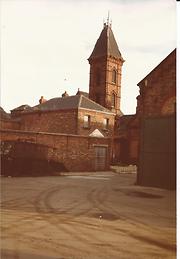 Part of the Library collection collection
Part of the Library collection collectionDated 1990
Taken around 1990
More detail » Hartlepool Fire Service - early beginnings
Hartlepool Fire Service - early beginnings
Records of the Council Minutes show that in 1887 (the year of Incorporation), the first Fire Brigade Chief was appointed, and in 1888 a steam fire engine was purchased to meet the requirements of the rapidly growing town.
The Brigade consisted of volunteers and paid firemen. Volunteer firemen were paid £2 per annum, plus an additional 2s 6d for each drill; when attending fires they were paid 4s 0d for the first hour and then 1s 6d for each subsequent hour of attendance.
The new Fire Station was completed in 1889 at a cost of £1,225, officially opening the following year. Prior to this, all the fire-fighting equipment was housed in a shed in the Market Yard, Lynn Street.
By 1938, after much reorganisation, the personnel consisted of two Officers, ten full-time firemen and twelve retained men. By 1946 the Brigade was controlled on a regional basis by the National Fire Service.
Compiled by Tony Hey.
More detail » Hosing Down
Hosing Down
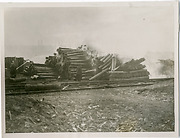 Donated by Hartlepool Museum Service
Donated by Hartlepool Museum ServiceA fireman and a worker hosing down smouldering pit props after the fire in 1922 on the Old Boys Field storage yard, Cleveland Road, Hartlepool.
More detail » Hosing down (2)
Hosing down (2)
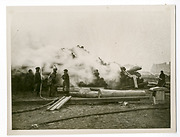 Donated by Hartlepool Museum Service
Donated by Hartlepool Museum ServiceFire Brigade and workers hosing down the smouldering timbers after the fire.
More detail » Hosing down (3)
Hosing down (3)
 Donated by Hartlepool Museum Service
Donated by Hartlepool Museum ServiceFire Brigade hosing down the timbers during the fire.
More detail » Hosing down (4)
Hosing down (4)
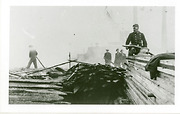 Donated by Hartlepool Museum Service
Donated by Hartlepool Museum ServiceFiremen and workmen hosing down the pit props.
More detail » Merryweather Fire Engine
Merryweather Fire Engine
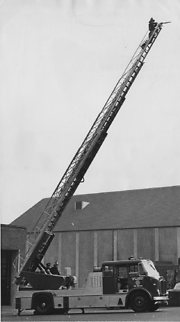 Donated by Hartlepool Museum Service
Donated by Hartlepool Museum ServicePart of the Robert Wood collection
Firemen demonstrating the extending ladders of the fire engine which is parked outside the fire station in Stockton Street. The side of the Gaumont Cinema provides the backdrop.
More detail » N.F.S. Merryweather Fire Engine
N.F.S. Merryweather Fire Engine
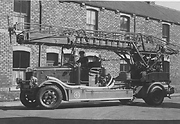 Donated by Hartlepool Library Service
Donated by Hartlepool Library ServiceA Merryweather Fire Engine with 75ft turntable ladder, Registration Number EF 4475. This engine is in the Second World War National Fire Service livery.
HHT&N 782
More detail »
 Old Fire Station Clark Street
Old Fire Station Clark Street
 Created by Bill Henderson
Donated by Bill Henderson
Created by Bill Henderson
Donated by Bill HendersonBuilt in 1890 in Barnard Street/ Clark Street, this was the first West Hartlepool Fire Station. This was taken in mid 1980s prior to demolition but the station had been out of use since 1959 when the new Stockton Street station was opened.
More detail » Stranton Fire Station
Stranton Fire Station
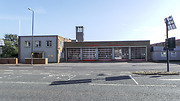 Created by Don Stephenson
Donated by Don Stephenson
Created by Don Stephenson
Donated by Don StephensonDated 2015
Stranton Fire Station, Stockton Street which was in use by November 1959 replacing the one in Barnard Street.
More detail » Timber Yard Fire Pump
Timber Yard Fire Pump
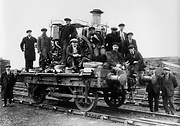 Donated by Douglas Ferriday
Donated by Douglas FerridayPart of the Hartlepool Library Service collection
A L.N.E.R. rail-mounted fire pump and its fire-fighting crew, c.1920. Do you know any of these men?
HHT&N 583
More detail » West Hartlepool Fire Engine
West Hartlepool Fire Engine
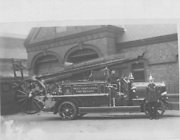 Donated by Hartlepool Museum Service
Donated by Hartlepool Museum ServiceOutside the fire station at Barnard Street, Stranton. Fire engine reg no. EF1085. The Leyland chassis was new in 1920 so the photo will be about that year.
More detail »




